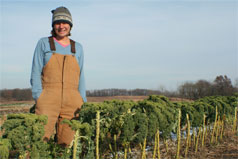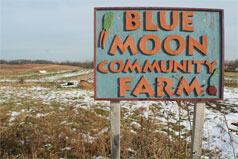

Also in life change:
New face of farming
 |
| Kristen Kordet spends her days sustainably farming on her two-acre plot near Oregon.
Photo courtesy of Anne Shapiro |
A longtime Wisconsin favorite gets a facelift from new owners
A two-wheeled existance
Jon Kendziera combined a background in mechanics with a love for bikes to become one of the hottest bike builders in the country
Homegrown hero
Kimberly native Mike Verstegen traded gridiron glory for a storybook life closer to his Wisconsin roots
Get a roll on
A roller derby revival touches down in the capital city
By Erika Janik
Heading south on Highway 14 from Madison, down a country road that seems far removed from the city only a few minutes away, past private drives, grassy fields, and rows of trees and shrubs, lies an open field of crinkly kale, lacey parsley and fluttering chard. This edible landscape is one of the places that Kristen Kordet calls home. Sporting a floppy cotton hat atop her chin-length blond hair, Kordet’s affinity for the land is as obvious in her blue eyes as it is in her earth-stained hands.
“Farming is who I am. It provides opportunities you can’t find in other areas of life. I get to interact with nature and be my own boss,” Kordet explains, a wide smile across her tanned face. “It isn’t a job—it’s a way of life.”
Listening to Kordet, it’s hard to believe that the 30-year-old had never even considered farming as a career when she graduated from college in 1999. But Kordet is among a growing number of smart, young and passionate people rejecting the nine-to-five for the promise of sustainable agriculture.
Although the fate of American farms has appeared bleak for decades, small-scale organic farms have emerged as an increasingly vibrant and viable alternative to the industrialization and globalization of agriculture. Consumer demand for organic food has skyrocketed and the number of organic farms across the United States has steadily risen in response. And Wisconsin is leading the way: Since 2003, the number of organic farms in Wisconsin has increased 25 percent and is second only to California in number of certified organic farms. In 2005, the Center for Integrated Agricultural Systems (CIAS) at the University of Wisconsin-Madison reported that Wisconsin had 640 certified farms and an estimated 250 more that are organic but not certified.
What makes this trend toward sustainable farming more notable, however, are the people toiling in the fields. Many of these new farmers are young, college-educated and have little or no farming background—a stark contrast to the thousands of rural Americans leaving the farms of their birth. This is particularly true of Community Supported Agriculture (CSA) farms, one of the increasingly popular forms of farm enterprises. On a CSA farm, consumers provide a portion of a farm’s operating expenses in the early spring, and in return, receive a portion of the farm’s produce throughout the season.
A CIAS survey of CSA farmers found that the average farmer is a full 10 years younger than his or her counterpart in conventional agriculture and more than 95 percent have attended or graduated from college. Many have fewer than 10 years experience on a farm.
John Hendrickson, senior outreach specialist for the Center for Integrated Agricultural Systems, and an organic farmer himself, attributes the growth in the number of young people interested in organic farming to concern about the environment. “Many people see organic farming as a way to strive toward a viable alternative to conventional agriculture and the global food system,” he says. “The agrarian ideal of the stalwart farmer working the land is meaningful and appealing to young people.”
This was certainly the case for Kordet. Growing up in the suburban Cleveland community of Euclid, Ohio, Kordet was far removed—both physically and psychologically—from the fields of Blue Moon Community Farm where she now spends most of her days. “My mom had a garden and we kind of helped, but food mainly came from the grocery store,” Kordet says.
As a kid, Kordet thought she wanted to be a teacher and entered Dennison College in the small town of Granville, Ohio, intending to major in math. She soon found herself bored with the subject and disillusioned by school, and considered dropping out altogether while she figured out what she wanted to do with her life. “I thought maybe I could work on a trail crew or something,” recalls Kordet, laughing. “My parents loved that idea.”
She soon found the inspiration she was looking for when she enrolled in a team-taught course that combined botany and English called “Landscape and Literature.” The class led her to a degree in environmental studies--and just for balance, a double-major in modern dance.
When Kordet left college, she landed a job as an environmental planner in Columbus, Ohio. To her surprise, many of the people she frequently contacted in her new job were farmers. “I talked to farmers about their land," Kordet says. "I thought I could help them and teach them something about conservation."
But she soon grew frustrated with her work as a planner. She wanted to be outside but found that she spent most of her days behind a desk, far removed from the land and water that had inspired her in school. She also found herself growing increasingly fascinated by the farmers she had come to know. “Growing food is so important and I found myself wanting to know how to do it myself,” she says.
So Kordet decided to look for a farm that would teach her how to grow. “I wanted to farm but I had no skills, so I thought that farms would be crazy to hire me,” Kordet says. To her surprise, she found farms willing to take a chance on people like her, and so at age 23, she gave up her desk job to spend her days planting, hoeing and harvesting.
Kordet found her first job on a Community Supported Agriculture (CSA) farm, a common point of entry for prospective farmers. There are more than 1,000 CSA farms in the United States — at least 60 in Wisconsin — and growing. Exact numbers are difficult to determine because many CSA farms do not keep accurate detailed records of their individual crops and the USDA Agricultural Census forms are not designed to accomodate small, diverse farms. Local figures are telling, however. The Madison Area CSA Coalition, for example, an alliance of south central Wisconsin CSA farms, grew from 16 farms in 2005 to 24 in 2006, with some 20 more expressing interest in joining for 2007. Some farms are dedicated entirely to CSA while others also sell through farm stands, farmers’ markets and wholesale. Often family-owned and intensively planted with fifty-plus crops, many of these small-scale farms depend on interns, and in exchange, provide hands-on experience in all aspects of farming practices to almost anyone with a desire to learn and an ability to work—hard.
Kordet spent her first year as an apprentice at Roxbury Farm, a CSA farm in Kinderhook, N.Y., driving a truck full of fresh produce into Albany and New York City for weekly deliveries. She moved up to crew manager her second year. After two years, though, Kordet decided the isolation of rural New York didn’t suit someone her age so she headed for the Midwest and the CRAFT (Collaborative Regional Alliance for Farmer Training) program.
CRAFT, managed by the CSA Learning Center at Angelic Organics in Caledonia, Ill., is a coalition of growers that trains prospective farmers like Kordet in everything from basic planting and harvesting skills, to business planning for the whole farm through seminars and on-farm training. CRAFT is one of a number of programs, including Farm Beginnings in Minnesota, the New England Small Farm Institute in Massachusetts, and Michael Fields Agricultural Institute in East Troy, Wis., that have appeared in the last few years to help train, support and encourage new organic farmers.
Hendrickson is quick to point out, though, that while these programs certainly help, farming remains, as it has always been, difficult. “Farming often gets romanticized," Hendrickson says. "There are some really amazing learning opportunities out there now but farming still means long, hard days of physically demanding labor."
Through CRAFT, Kordet spent the next two years interning on one of the CRAFT member farms, JenEhr Family Farm in Sun Prairie, Wis. “Learning to work on a farm was an incredibly humbling experience,” Kordet says. “I went from being at the top of my college class to making lots of mistakes.”
After completing the CRAFT program, Kordet decided she wanted to start her own farm. She had recently moved into a housing co-op in Madison where she met Jake Hoeksema. Like Kordet, Hoeksema was young and ambitious. He had worked on a few farms himself and was eager to be on his own.
So in 2004, Kordet and Hoeksema started Blue Moon Community Farm, a two-acre vegetable and pastured poultry farm with 20 CSA members. Unable to afford land, a common problem for beginning farmers, they rented land from a private landowner near Oregon. Kordet also took a waitressing job at L’Etoile Restaurant in Madison to help support herself, working days on the farm and evenings at the restaurant. “It’s really hard to waitress and farm,” Kordet says. “But the reason I can farm right now is because I have a waitressing job.”
While Kordet and Hoeksema’s first season together went well, year two was another story. “It was horrible. There was no rain and we had no irrigation systems. It was so stressful—our CSA was in jeopardy and we were getting on each other’s nerves,” Kordet says. At the end of the growing season, Kordet and Hoeksema began to reassess what they wanted to do with the farm. Hoeksema decided he didn’t want to work so hard for so little money and left the farm.
“We both arrived at different visions of what was going to happen,” Kordet says. “I felt like farming is what I really want to do. What Jake did was very brave because it would be so much easier to decide not to farm for a while, but a big part of me would be missing if I did that. The farm is a part of my identity.”
Undaunted by the challenges ahead of her, Kordet now farms alone. She hired three people to supplement for the loss of Hoeksema and now teaches others how to farm. Blue Moon has grown to a 50-member CSA and Kordet’s produce now appears on the menu at Madison restaurants such as L’Etoile Restaurant and the Dardanelles, in addition to her weekly farm stand at two Madison farmers’ markets. Renting land has become increasingly problematic and frustrating for Kordet. So, while she is actively looking for new places to farm, she has no intention of looking for a new career.
“I’m a farmer now because I can’t imagine being anything else. I can’t imagine having a regular schedule anymore. Everyday is like a game, a constant challenge to figure out what to do,” Kordet says. “There’s really nothing I feel as excited about as farming.”
Find a farm. Check out this interactive map to search for local organic farms by county.
 |
|
Blue Moon Community Farm is one of a growing number of small scale, back-to-basics farms popping up in Wisconsin. Photo courtesy of Anne Shapiro |
home | alternatives | fulfillment | life change | climate | lifestyle
about | subscribe | contact | advertise | site map
_____________________________________________________________
(c) curb magazine 2006